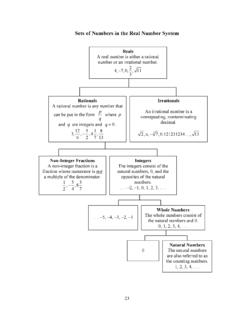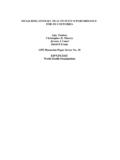Transcription of The Personal Numbering System of the Australian Army
1 What's In A number ? The Personal Numbering System of the Australian Army by 2151240i The first thing a soldier generally learns, on the very first day of enlistment, is his or her Personal number . Those readers with Army service (probably Navy and Air Force as well) will surely remember their first day of service as they, and everyone else around them, spent the day mumbling a string of digits to themselves as they strove to commit that magic number to memory. And woes betide the individual if that number was NOT committed to permanent memory by the end of the day. Readers will doubtless recall the various dodges utilised by those with a less than perfect memory in an effort to avoid the wrath of their instructors.
2 Numbers would be written inside sleeve cuffs, inside the crown of the bush hat, on the back of the wrist, on the palm of the hand. Having your brew mug in your hand when pounced on by a predatory corporal intent on catching you out in the commission of that most unpardonable of military sins, not being able to remember your number , was always a life saver. Since your number was required to be written on your mug in permanent marker, in nice big digits, the mug was always good for a quick desperate glance! Relevance of Service Numbers The question that can legitimately be asked, of course, is what is the relevance of service numbers to military historians?
3 Well, first of all, the service number is one way of positively identifying a particular soldier when carrying out research. Secondly, from a purely Australian context, as Australia is one of the few countries in the world to habitually issue service medals with the recipients name and number on them, again the regimental or service number is a critical element in researching medals. Background The British Experience Having said all that, service numbers as we know them have been around since 1830. Not surprisingly, Australian practice has fairly closely followed British practice. It is therefore appropriate that the British experience be examined in order to place the Australian experience in context.
4 In 1830 the British Army ordered that every soldier then serving or on enlistment was to be allotted a regimental number . The main reason for the establishment of regimental numbers appears to have been as a tool to counter fraud. With each man now allocated a number unique to him self (if not unique in the Army) it was harder for dishonest officers and senior NCO s to defraud the government by misrepresenting pay accounts. The Numbering System established by the British Army in 1830 was a true Regimental number System , with numbers being allocated in each regiment and corps starting from 1 . This was definitely a step in the right direction, but was not without shortcomings.
5 The first of these was that officers were not included in the Numbering System . Secondly, the numbers were not unique to the man. Given that in 1830 the order of battle of the British Army included 3 regiments of foot guards, 99. regiments of foot and 26 regiments of cavalry, then it can be seen that, even if the various support arms, corps and departments are excluded, there were at least 128. men in the army with the Regimental number 1 .ii Taking the 46th Regiment of Foot (later the Duke of Cornwall s Light Infantry) as an example, between 1830 and 2 October 1856, when a new Numbering sequence was ordered, Regimental Numbers 1 to 4211 had been issued for the 46th.
6 The new Numbering sequence of 1856 again started with 1 but serving members of the regiment kept their old number , the new sequence being applied to new enlistments. The 1856 sequence is known to have gone up as high as In 1874 the 46th was linked with the 32nd Regiment as a result of the first of the Cardwell reforms. Under this reform, newly linked units were in turn linked to a particular Sub-District or Brigade Area, in the case of the 32nd/46th, Sub-District No. 35. From this date Regimental Numbers were issued by the Sub-District, with a new sequence, again starting at 1 , and again only applied to new enlistments. New enlistments were differentiated by addition of the suffix 35B/ to their number , thus the first soldier enlisted under the new sequence was allotted the number 35B/1.
7 Soldiers already serving in the unit had the prefix 32/ or 46/ , respectively, added to their existing number . This System remained in force until August 1881 when the amalgamation of the 32nd and 46th was completed and the unit emerged as the 1st and 2nd Battalions of the Duke of Cornwall s Light Infantry (DCLI). At that time numbers up to 35B/1592 had been Yet another sequence of regimental numbers was ordered in August 1881 and the first new enlistment into the DCLI was allotted the regimental number 1 in this sequence. Once again, already serving soldiers retained their old numbers. From Regimental number 1 the new sequence is known to have gone up to This incredibly high number is of course explained by the huge expansion of the DCLI during the First World War, when the 1881 Numbering sequence continued.
8 On 1 March 1919 the DCLI, along with the rest of the British Army, commenced a new Numbering sequence, with a zero prefix to one, two, three and four digit numbers. These numbers, which applied to new enlistments and transferees only, commenced at 08, with no record or explanation as to why numbers 01 07 were not allotted. When this sequence was rendered obsolete by the introduction of Army Numbers in 1920, DCLI had allotted numbers up to In October 1920, strict Regimental Numbers were abolished and were replaced by Army Numbers. While issued from a central sequence, however, the DCLI and all other regiments and corps of the army were allotted a block of numbers unique to the regiment.
9 In the case of DCLI, the block allotted was 5429001 5485000. Thus the 1920 numbers can still be viewed as Regimental Numbers . For the first time these new numbers were made retrospective so every serving member of the DCLI was allotted a new number , with new enlistments being issued numbers from the same block on the date of Regimental Numbers ceased to be issued in the British Army in October 1950 when the army finally did away with numbers specific to units and introduced a single sequence for all new recruits, both Regular and Territorial Army. While serving soldiers retained their old numbers, from October 1950 all new recruits were allotted numbers from a central sequence, which started at The Australian Experience Pre-World War One Turning now to Australia, prior to 1914 the Australian Military Forces (AMF).
10 Followed the British Army System of allotting regimental numbers to its personnel. Under this System , each unit was responsible for issuing numbers to its members, each unit starting its Numbering sequence from 1 . Doubtless records exist in the orders of the military forces of the various colonies that gave legal basis to the System . To date it has not been possible to locate such orders. However, a number of rolls held by the Australian War Memorial (AWM) for members of the New South Wales Military Force certainly prove the fact that the British style regimental number System was followed by at least one of the colonies. The AWM holds a copy of the Descriptive Roll Book of the Artillery, New South Wales Military Force , which lists details of every soldier enlisted in the NSWA from 1871 The first entry in the book is for Henry Green, who was attested on 7.







